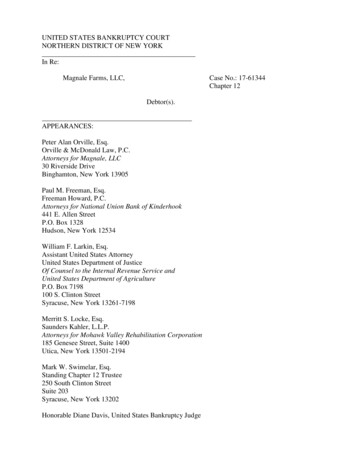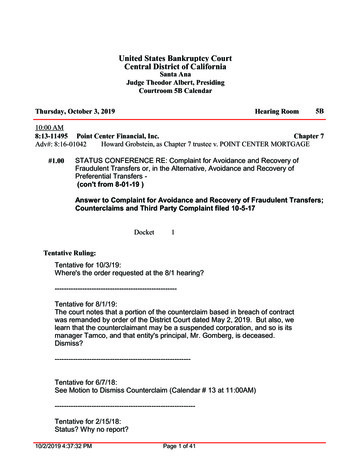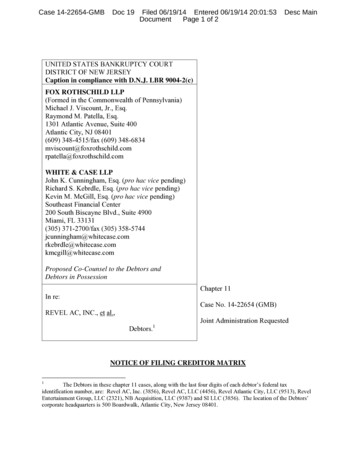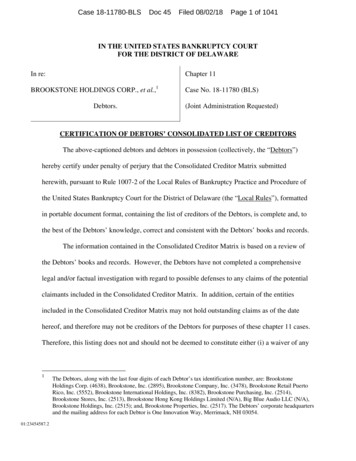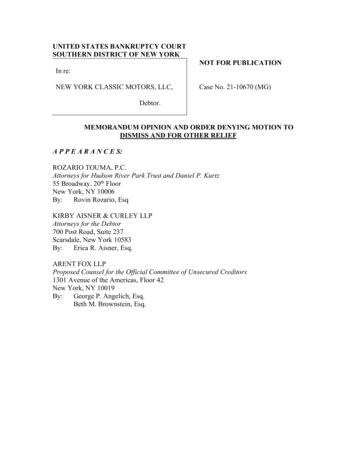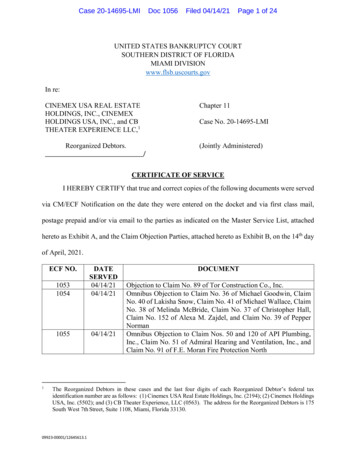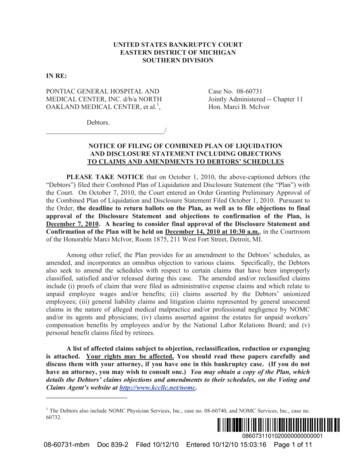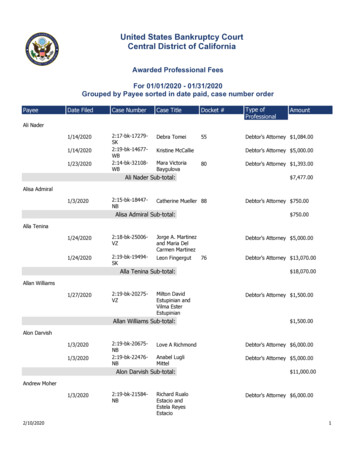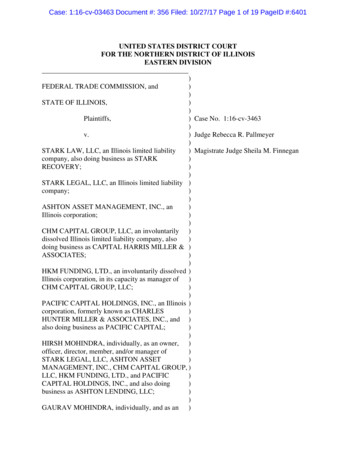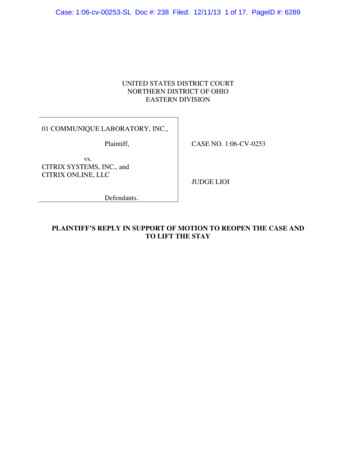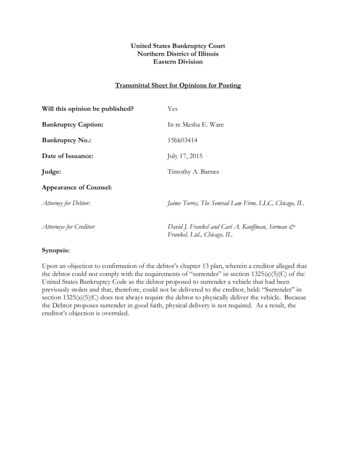
Transcription
United States Bankruptcy CourtNorthern District of IllinoisEastern DivisionTransmittal Sheet for Opinions for PostingWill this opinion be published?YesBankruptcy Caption:In re Mesha E. WareBankruptcy No.:15bk03414Date of Issuance:July 17, 2015Judge:Timothy A. BarnesAppearance of Counsel:Attorney for Debtor:Jaime Torres, The Semrad Law Firm, LLC, Chicago, ILAttorneys for Creditor:David J. Frankel and Cari A. Kauffman, Sorman &Frankel, Ltd., Chicago, ILSynopsis:Upon an objection to confirmation of the debtor’s chapter 13 plan, wherein a creditor alleged thatthe debtor could not comply with the requirements of “surrender” in section 1325(a)(5)(C) of theUnited States Bankruptcy Code as the debtor proposed to surrender a vehicle that had beenpreviously stolen and that, therefore, could not be delivered to the creditor, held: “Surrender” insection 1325(a)(5)(C) does not always require the debtor to physically deliver the vehicle. Becausethe Debtor proposes surrender in good faith, physical delivery is not required. As a result, thecreditor’s objection is overruled.
UNITED STATES BANKRUPTCY COURTNORTHERN DISTRICT OF ILLINOISEASTERN DIVISION)))))))In re:Mesha E. Ware,Debtor.Case No. 15bk03414Chapter 13Judge Timothy A. BarnesCERTIFICATE OF SERVICEI hereby certify that I caused copies of the attached Memorandum Decision and Order tobe served on all persons on the electronic service list; I also caused copies to be sent to the belowservice list by first class United States mail in properly addressed envelopes with postage prepaid thisJuly 17, 2015.Lauren HargroveLaw ClerkSERVICE LISTPersons Receiving Electronic Service and Service by United States MailCounsel to Mesha E. WareJaime Torres, Esq.The Semrad Law Firm, LLC20 S Clark St., 28th FloorChicago, IL 60603Counsel to Santander Consumer USA Inc.David J. Frankel, Esq.Cari A. Kauffman, Esq.Sorman & Frankel, Ltd.180 N LaSalle St., Ste. 2700Chicago, IL 60601
UNITED STATES BANKRUPTCY COURTNORTHERN DISTRICT OF ILLINOISEASTERN DIVISIONIn re:Mesha E. Ware,Debtor.)))))))Case No. 15bk03414Chapter 13Judge Timothy A. BarnesTIMOTHY A. BARNES, Judge.MEMORANDUM DECISIONThe matter before the court arises out of the Objection of Santander Consumer USA Inc. toConfirmation of Debtor’s Proposed Chapter 13 Plan (the “Objection”), filed by SantanderConsumer USA Inc. (“Santander”), objecting to the chapter 13 plan of Mesha E. Ware (the“Debtor”). The Debtor asserts that surrender of a vehicle under section 1325(a)(5)(C) does notrequire her to physically deliver that vehicle when she is incapable of doing so through no fault ofher own. Santander conversely argues that if the Debtor is unable to tender physical delivery, theDebtor’s plan should not be confirmed.For the reasons stated below, the Objection is overruled.JURISDICTIONFederal district courts have “original and exclusive jurisdiction” of all cases under title 11 ofthe United States Code (the “Bankruptcy Code”). 28 U.S.C. § 1334(a). Federal district courts alsohave “original but not exclusive jurisdiction” of all civil proceedings arising under the BankruptcyCode, or arising in, or related to cases under title 11. 28 U.S.C. § 1334(b). District courts may,however, refer these cases to the bankruptcy judges for their districts. 28 U.S.C. § 157(a). Inaccordance with section 157(a), the District Court for the Northern District of Illinois has referredall of its bankruptcy cases to the Bankruptcy Court for the Northern District of Illinois. N.D. Ill.Internal Operating Procedure 15(a).A bankruptcy judge to whom a case has been referred may enter final judgment on any coreproceeding arising under the Bankruptcy Code, or arising in a case under the Bankruptcy Code.28 U.S.C. § 157(b)(1). Plan confirmation and objections thereto may arise in a case only under title11 and are specified as core matters in which this court has jurisdiction to enter final orders.28 U.S.C. § 157(b)(2)(B), (E) and (L). In re Nicola, 244 B.R. 795, 796 (Bankr. N.D. Ill. 2000)(Lefkow, J.). Such matters, thus, are within the court’s constitutional authority. Stern v. Marshall, 131S. Ct. 2594, 2618 (2011).Accordingly, final judgment is within the scope of the court’s jurisdictional andconstitutional authority.
PROCEDURAL HISTORYIn considering the Objection, the court has reviewed and considered the Objection [Dkt.No. 15], the attached exhibits submitted in conjunction therewith, and the following fileddocuments in the bankruptcy proceeding:(1) Chapter 13 Plan (the “Plan”) [Dkt. No. 6];(2) Modified Chapter 13 Plan (the “Modified Plan”) [Dkt. No. 20];(3) Debtor’s Response to Santander Consumer’s Objection to Confirmation (the “Response”)[Dkt. No. 27]; and(4) Reply of Santander Consumer USA Inc. in Support of Its Objection to Confirmation (the“Reply”) [Dkt. No. 29].Though the foregoing items do not constitute an exhaustive list of the filings in thebankruptcy case, the court has taken judicial notice of the contents of the docket in these matters.See Levine v. Egidi, No. 93C188, 1993 WL 69146, at *2 (N.D. Ill. Mar. 8, 1993) (authorizing abankruptcy court to take judicial notice of its own docket); In re Brent, 458 B.R. 444, 455 n.5 (Bankr.N.D. Ill. 1989) (Goldgar, J.) (recognizing same).BACKGROUNDOn February 15, 2011, the Debtor purchased a 2006 Chevrolet Monte Carlo (the “Vehicle”)financed by Santander pursuant to a retail installment contract. That contract called for an interestrate of 24.99% and equal monthly payments to Santander, each in the sum of 475.92.Sometime in October 2012, the Vehicle was allegedly stolen from a Jewel-Osco parking lotlocated at 2203 W. 87th Street, Chicago, IL. The Debtor promptly filed a police report with theChicago Police Department and an insurance claim with KAI Advantage Auto Insurance. InFebruary 2013, for reasons not disclosed to the court, the insurance claim was denied. The Debtorinformed Santander of the theft, the police report and the insurance claim’s denial, but made nofurther payments to Santander or efforts to satisfy the debt owed. In the two years after theinsurance claim was denied, Santander never attempted to contact the Debtor regarding the Vehiclenor did Santander commence any action in state court for the recovery of the Vehicle or forcollection of the underlying debt. Santander did not file a claim with or pursue action against KAIAdvantage Auto Insurance.On February 2, 2015, the Debtor filed a voluntary petition under chapter 13 of theBankruptcy Code. Neither the Debtor’s schedules nor the Plan addressed Santander’s secured claimor the Vehicle. Santander filed its secured claim as to the Vehicle in the amount of 18,806.67 andobjected to confirmation of the Plan on the grounds that the Plan omitted its claim. The Debtorlater filed the Modified Plan which contains the following language: “Debtor hereby surrenders the2006 Chevrolet Monte Carlo to Santander Consumer Usa [sic] in full satisfaction of its securedclaim.”Santander thereafter asserted the objection at bar, arguing that the Debtor cannot satisfysection 1325(a)(5)(C) by providing for surrender in the plan alone, as the Debtor is required to2
physically deliver the Vehicle to Santander or pay Santander’s allowed secured claim in full. TheDebtor responds that “surrender” under section 1325(a)(5)(C) of the Bankruptcy Code does notrequire actual physical delivery of the Vehicle, therefore Santander’s secured claim is satisfied simplyby the surrender plan provision alone.THE MEANING OF “SURRENDER”This is a case that turns on the meaning of the term “surrender” as used in the BankruptcyCode.1 As this court has previously stated:The Supreme Court has stated that “[t]he task of resolving [a] dispute overthe meaning of [a statute] begins where all such inquiries must begin: with thelanguage of the statute itself.” United States v. Ron Pair Enterprises, Inc., 489 U.S. 235,241 (1989); In re Randle, 358 B.R. 360, 362 (Bankr. N.D. Ill. 2006) (Doyle, J.), aff'd,No. 07C631, 2007 WL 2668727 (N.D. Ill. July 20, 2007). Where the language of thestatute is unambiguous, no further inquiry is necessary or appropriate. Sebelius v. Cloer,659 U.S. , , 133 S. Ct. 1886, 1895 (2013); In re Vecera, 430 B.R. 840, 842(Bankr. S.D. Ind. 2010) (citing Griffin v. Oceanic, Inc., 458 U.S. 564, 570 (1982)). Absentcontrary definitions within the statute itself, words in a statute are presumed to havetheir “ordinary, contemporary, common meaning.” Pioneer Inv. Servs. v. BrunswickAssocs., 507 U.S. 380, 388 (1993) (citing Perrin v. United States, 444 U.S. 37, 42 (1979)).In re Walker, 502 B.R. 324, 327 (Bankr. N.D. Ill. 2013) (Barnes, J.).As in Walker, the inquiry thus begins with the statute itself. Section 1325 provides that “thecourt shall confirm a [chapter 13 reorganization] plan” if the plan, with respect to each allowedsecured claim provided for by the plan, allows for “surrender [of] the property securing such claim tosuch holder.” 11 U.S.C. § 1325(a)(5)(C) (emphasis added). Neither section 1325 specifically nor theBankruptcy Code as a whole provides a definition, however, of the word “surrender.”Anticipating such an instance, the Seventh Circuit has stated:We examine the statute according to the conventional rules of statutory construction:absent statutory definitions, we accord words and phrases their ordinary and naturalmeaning and avoid rendering them meaningless, redundant, or superfluous; we viewwords not in isolation but in the context of the terms that surround them; welikewise construe statutes in the context of the entire statutory scheme and avoidrendering statutory provisions ambiguous, extraneous, or redundant; we favor themore reasonable result; and we avoid construing statutes contrary to the clear intentof the statutory scheme.It is tempting to simply adopt Judge Schmetterer’s well-reasoned opinion on this subject, as the factsare very close. See Nuvell Credit Corporation v. Ross (In re Ross), 359 B.R. 690, 698 (Bankr. N.D. Ill. 2007)(Schmetterer, J.). The result would be the same. Because, however, the issues raised herein are frequentlylitigated in this court (and others), the court believes further analysis and discussion is warranted, to wit thisMemorandum Decision.13
In re Merchants Grain, Inc., 93 F.3d 1347, 1353-54 (7th Cir. 1996).2As a result, below, the court first looks to the “ordinary and natural meaning” of the term.The court then considers that statutory scheme within which the term is used, followed by some ofthe cases that have interpreted the term within that scheme. Following that, the court considers theuse of alternative terms in the Bankruptcy Code, as that too can provide insight as to the meaning ofthe term.A.The Ordinary and Natural Meaning of “Surrender”The Oxford English Dictionary provides a number of alternative definitions of the term“surrender.” Of most interest is, perhaps, the following: “The giving up by a bankrupt of hisproperty to his creditors or their assignees; also, his due appearance in the bankruptcy court forexamination, as formerly required by the bankruptcy acts.” OXFORD ENGLISH DICTIONARY (onlineversion, November 2010), http://www.oed.com (last visited July 17, 2015).This definition turns on the meaning of “property,” which is an expansive concept underbankruptcy law. “[T]he term ‘property’ has been construed most generously and an interest is notoutside its reach because it is novel or contingent or because enjoyment must be postponed.” Segal v.Rochelle, 86 S. Ct. 511, 515 (1966); see also In re Yonikus, 996 F.2d 866, 869 (7th Cir. 1993), abrogated onother grounds, Law v. Siegel, 134 S. Ct. 1188 (2014); Mason v. Costello (In re Klarchek), 508 B.R. 386, 39495 (Bankr. N.D. Ill. 2014) (Barnes, J.). As such, surrender of “property” could be accomplishedunder these definitions by surrendering rights alone.By way of comparison, Black’s Law Dictionary defines “surrender” as the “giving up of aright or claim; release; . . . [t]he delivery of an instrument so that the delivery releases the delivererfrom all liability.” BLACK’S LAW DICTIONARY 1673 (10th ed. 2014). Further, one prominentbankruptcy treatise has defined “surrender” as the “relinquishment of any rights in the collateral,”including the right to possess the collateral. 8 Collier on Bankruptcy ¶ 1325.06[4] (15th ed. 2005).These definitions suggest that surrender of property involves either or both a transfer of theproperty and of the rights thereto, but provide no guidance as to whether the physical delivery ofthat property is mandatory. As a result, the ordinary and natural meaning of the term “surrender” isnot outcome determinative, and the court must look further.B.“Surrender” in the Bankruptcy CodeAs noted above, the Seventh Circuit has provided guidance where the ordinary meaning isunclear, directing the court to “construe statutes in the context of the entire statutory scheme.”Merchants Grain, 93 F.3d at 1353-54. The Supreme Court has provided similar guidance, stating that:Undoubtedly, there is a natural presumption that identical words usedin different parts of the same act are intended to have the samemeaning. But [this] presumption . . . readily yields whenever there is“As early as in Bacon’s Abridgment, sect. 2, it was said that ‘a statute ought, upon the whole, to be soconstrued that, if it can be prevented, no clause, sentence, or word shall be superfluous, void, orinsignificant.’” Washington Mkt. Co. v. Hoffman, 101 U.S. 112, 115-16 (1879).24
such variation in the connection in which the words are used asreasonably to warrant the conclusion that they were employed indifferent parts of the act with different intent.Atl. Cleaners & Dyers v. United States, 286 U.S. 427, 433 (1932) (internal citation omitted).We can, therefore, deepen our understanding of the requirements of “surrender” in section1325(a)(5)(C) by examining the definition and interpretation of “surrender” used in other parts ofthe Bankruptcy Code. See, e.g., 11 U.S.C. § 362(h)(1)(A) (“the debtor will either surrender suchpersonal property or retain it”); 11 U.S.C. § 365(d)(4)(A) (“the trustee shall immediately surrenderthat nonresidential real property to the lessor”); 11 U.S.C. § 521(a)(2)(A) (the debtor shall file “astatement of his intention with respect to the retention or surrender of such property”); 11 U.S.C.§ 727(d)(2) (the debtor failed “to deliver or surrender such property to the trustee”); 11 U.S.C.§ 1110(a)(3)(B) (“to be surrendered or returned by the debtor”); 11 U.S.C. § 1143 (“a plan requirespresentment or surrender of a security”); 11 U.S.C. § 1225(a)(5)(C) (“the debtor surrenders theproperty securing such claim to such holder”).3 There is no significant variation between the uses of“surrender” so as to warrant the conclusion that they were employed in different parts of theBankruptcy Code with different intent.In examining the foregoing, one immediate and striking observation can be made: In threeof the eight (seven preceding and section 1325) sections employing “surrender,” it is used inopposition to a term that implies physical delivery. See 11 U.S.C. § 727(d)(2) (“deliver orsurrender”); 11 U.S.C. § 1110(a)(3)(B) (“surrendered or returned”); 11 U.S.C. § 1143 (“presentmentor surrender”). In two further uses, “surrender” is used in opposition to “retain” or “retention.”See 11 U.S.C. § 362(h)(1)(A) (“surrender or retain”); 11 U.S.C. § 521(a)(2)(A) (“retention orsurrender”).Giving every word of the statute meaning and avoiding making those words “ambiguous,extraneous, or redundant,” Merchants Grain, 93 F.3d at 1353-54, the former examples imply“surrender” lacks the meaning of “delivery,” “return” or “presentment.” Otherwise, such wordswould be extraneous or redundant. Further, the latter examples would be meaningless if propertycould not be retained, unless of course that property may be surrendered.What remains are sections 365 and 1225 of the Bankruptcy Code. As to section 362,surrender of nonresidential real property (i.e. leased commercial space) can mean either legal orphysical surrender, or both, and the case law reflects that possibility. In re Trak Auto Corp., 277 B.R.655, 664 (Bankr. E.D. Va. 2002) (surrender accomplished by tendering possession or, if nopossession, notifying landlord of surrender); In re Ames Dept. Stores, Inc., 306 B.R. 43, 62 n. 68, 69(Bankr. S.D.N.Y. 2004) (same). As to section 1225, the case law is sparse and unhelpful.One of these sections has legislative history, however, and has given rise to case law that maybe helpful in this regard. Stated more fully than above, section 521 provides that a debtor must,“within thirty days after the date of the filing of a petition under chapter 7 of this title or on orbefore the date of the meeting of creditors, . . . file with the clerk a statement of his intention withThough surrender is only used once in the Bankruptcy Rules, that use is with respect to “surrendervalue” and is not of help in this analysis. See Fed. R. Bankr. P. 2015(a)(4).35
respect to the retention or surrender of” any property of the estate securing debt listed in the debtor’sschedules. 11 U.S.C. § 521(a)(2)(A) (emphasis added).The legislative history of section 521 supports the interpretation of “surrender” as notalways requiring physical delivery. The rationale in drafting section 521 was to ensure that securedcreditors received early notice of a debtor’s intentions with respect to the creditor’s collateral:The automatic stay prohibits contact with the debtor and [beforesection 521] typically the secured creditor would know nothing aboutthe fate of its collateral. The complaint was that the secured creditorwould often incur the expense of filing an adversary proceeding tolift the stay only to learn that the debtor all along intended tosurrender the property without a contest. The solution to theproblem was to require an early disclosure of the debtor’s intentionwith respect to the property and early performance.Home Owners Funding Corp. of Am. v. Belanger (In re Belanger), 118 B.R. 368, 370-71 (Bankr. E.D.N.C.1990) (citing Proposed Consumer Bankr. Improvements Act of 1981: Hearings Before the Subcomm. on Courts ofthe S. Comm. on the Judiciary, 97th Cong., 1st Sess. J-97-11 (1981)), aff’d, 128 B.R. 142 (E.D.N.C.), aff’dsub nom. In re Belanger, 962 F.2d 345 (4th Cir. 1992). To combat this problem, Congress draftedsection 521 to require debtors to disclose affirmatively their intent to surrender or retain collateralsubject to secured claims. In re Cornejo, 342 B.R. 834, 836 (Bankr. M.D. Fla. 2005). “The legislativehistory does not support an interpretation of the term surrender as requiring a debtor to physicallydeliver actual possession of the collateral to the creditor’s place of business when it is not feasible.”Id.In Cornejo, a debtor proposed to surrender his vehicle, which was in a repair shop and subjectto a mechanic’s lien. Cornejo, 342 B.R. at 835. The Cornejo court determined that requiring thedebtor to physically deliver his vehicle to the creditor to effectuate section 521 surrender was notfeasible or consistent with the debtor’s right to a fresh start. Id. at 835-36 (noting that the recordwas void of any indication of fraud or bad faith).Other courts have agreed. The United States Bankruptcy Court for the District ofColumbia, for example, interpreted “surrender” in section 521 as not requiring physical delivery. Inre Kasper, 309 B.R. 82, 91 (Bankr. D.D.C. 2004). Under section 521(a)(4), a debtor’s duty tosurrender property to the trustee for administration of the estate always exists. Id. at 90. A debtorcomplies with the requirements of surrender in 521(a)(4) by “allowing the trustee to administer theproperty” and “not [interfering] with the processes under the Bankruptcy Code for administration ofthe property as property of the estate.” Id. at 91. The trustee may decide not sell the property so,despite the debtor’s duty to surrender, the debtor need not always physically turn that property overto the t
Chicago Police Department and an insurance claim with KAI Advantage Auto Insurance. In February 2013, for reasons not disclosed to the court, the insurance claim was denied. The Debtor informed Santander of the theft, the police report and the insurance claim’s denial, but made no further p
